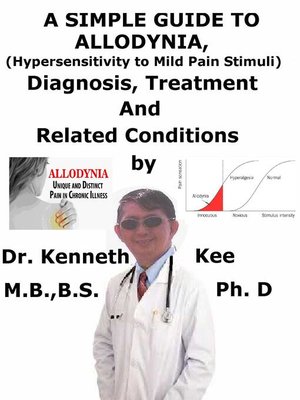A Simple Guide to Allodynia, (Hypersensitivity to Mild Pain Stimuli) Diagnosis, Treatment and Related Conditions
ebook
By Kenneth Kee

Sign up to save your library
With an OverDrive account, you can save your favorite libraries for at-a-glance information about availability. Find out more about OverDrive accounts.
Find this title in Libby, the library reading app by OverDrive.



Search for a digital library with this title
Title found at these libraries:
| Loading... |
This book describes Allodynia, Diagnosis and Treatment and Related Diseases
Allodynia is a type of neuropathic pain (nerve pain).
Allodynia is an infrequent symptom that can happen from several chronic nerve-related disorders.
When the patient is feeling it, the patient senses pain from stimuli that do not normally cause pain.
Stimuli such as lightly touching the skin or brushing the hair might feel painful.
Allodynia is rare even though it is frequent in people with neuropathic pain.
15 to 50 percent of people with neuropathic pain have allodynia.
There are 3 forms of allodynia:
Tactile (static) allodynia: a severe sensation of pain results from gentle touch or pressure
Thermal allodynia: mild changes in temperature produces pain, such as a small drop of cold water that results in significant discomfort
Mechanical (dynamic) allodynia: a painful sensation that happens when a person is affected by normally harmless stimuli moving across the skin, such as light touch
People with allodynia are excessively sensitive to touch.
Things that do not normally produce pain can be very painful.
These may involve cold temperatures, brushing hair or wearing a cotton t-shirt.
Allodynia can result from several disorders.
The most frequent causes of allodynia are diabetes, shingles, fibromyalgia and migraine headaches.
Some underlying disorders and lifestyle factors can produce allodynia such as:
Fibromyalgia
Migraine headaches
Post-herpetic neuralgia, a complication of shingles
Peripheral neuropathy or damage to a group of nerves
Shingles
Opioid use
Chemotherapy
Diet and nutrition factors
Diabetes
Trauma
The main symptom of allodynia is the pain from stimuli that do not normally produce pain.
In some patients, the patient might feel hot or cold temperatures painful.
The patient might feel the gentle pressure on the skin painful.
The patient might feel pain in reaction to a brushing sensation or other movement along the skin or hair.
If the patient notices that the skin has become more sensitive to touch than normal, the patient can do a self-test to determine whether the patient may have symptoms of allodynia:
Brush a dry cotton pad on the skin.
Apply a hot or cold compress.
If the patient feels a painful tingling feeling in reaction to any of these stimuli, the patient might have allodynia and should make an appointment with a doctor to confirm this.
The doctor will examine for any underlying disorders, such as diabetes, and ask the patient about symptoms.
The report of the quality of pain is very important when determining whether pain is neuropathic, like allodynia.
Burning
Throbbing
Constant
Intermittent
Radiating
Additional tests for the underlying cause may be:
Blood tests, such as full blood count or FBC and urine tests
MRI or CT scan to look for signs of MS, stroke or another disease or injury
Electromyography (EMG) and nerve conduction study (NCS).
Quantitative sensory testing (QST),
If the doctor believes the patient might have diabetes, they will likely order blood tests to measure the level of blood glucose.
Treatments may involve:
Oral medicines, such as ibuprofen or pregabalin
Topical treatments, such as lidocaine ointment or a capsaicin patch
Non steroidal anti-inflammatory drugs, such as naproxen or indomethacin
Lifestyle changes, like exercise and dietary changes
Cognitive behavioral therapy
Spinal cord stimulation
Nerve blockers
Surgery
TABLE OF CONTENT






